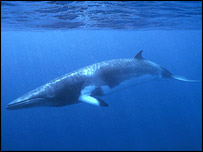 |
 |
 |
 Editorials | Environmental | February 2005 Editorials | Environmental | February 2005  
'No Surge' In Minke Whale Numbers
 Paul Rincon - BBC Paul Rincon - BBC


| Minke whales reach about 10m at maturity (Photo: Francois Gohier)

|
Genetic research on Tokyo whale meat reveals that minke whales may not be experiencing an unprecedented surge in numbers as had previously been thought.

It was said the species' success had hampered the recovery of other whales, and that hunting of minkes would be sustainable and beneficial.

But the tests indicate no such number boom - only a steady population growth over a period of a million years.

The results were outlined at a major science conference in Washington DC.

Steve Palumbi, of Stanford University in California, examined whale meat in Japanese shops.

The meat, sold legally, comes from carcasses of whales taken for scientific research under the rules set down by the International Whaling Commission.

The American scientist looked at the variations in the mitochondrial DNA (mtDNA).

This DNA is found in the cell's "powerhouses" and is passed down through the generations on the maternal side only.

Because researchers know how quickly mtDNA accumulates errors, they can assign rough timescales to the population changes they see.

Climate Conundrum

The Stanford researcher used DNA sequences from 179 individuals to build a family tree that led back to a "minke Eve" alive around one million years ago.

"The size and depth of that gene tree tells you a lot about past population size, and the shape of that gene tree tells you a lot about past population size changes," he told the annual meeting of the American Association for the Advancement of Science (AAAS).

"The results show that Antarctic minke whales have the greatest genetic diversity of any whale population we have ever sampled."

The information could prove critical to current discussions of the International Whaling Commission (IWC).

The Institute of Cetacean Research in Japan has proposed that minke whales used to be rare and have only become abundant in recent times. They estimate that numbers have increased from around 100,000 to approximately 800,000 just in the last hundred years.

This, they claim, is hindering the recovery of other Antarctic whale species - pointing to the need for resumed whaling.

But the genetic results tell a different story, showing a rapid population expansion and steady growth with no appreciable booms and busts.

"There is really no evidence at all that minke whales right now are so abundant that they are hindering the recovery of great whales in Antarctica," said Dr Palumbi.

"Minkes were not rare before the age of Antarctic whaling and their present population size is not a reflection of a recent, huge increase. They are not weeds that need to be pulled."

The findings also reveal that minke whales are extraordinarily resilient to climate change.

Their population sizes have not been noticeably affected by large climatic fluctuations over the past million years; though researchers are at a loss to explain why. | 
 | |
 |



